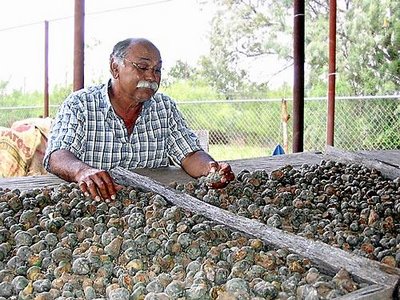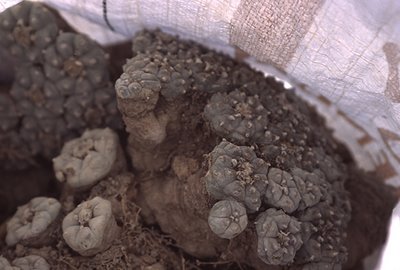I’m aware that this Seattle Times article has been available on the net for some time; but I think it fits well with the theme intoned by the posts on proper peyote harvesting techniques and the Huichol peyote pilgrimage, so here goes...
In Deep South Texas, peyote harvest dwindling
By Sylvia Moreno (2005)

Salvador Johnson is one of four licensed peyote distributors left in the United States. He has harvested the plant for 47 years.
MIRANDO CITY, Texas — In the heart of Rio Grande brush country, Salvador Johnson works a patch of land just east of the Mexican border that is sacred to Native Americans.
Spade in hand, eyes scanning the earth as he pushes through the spiny brush, Johnson searches the ground carefully. “This is good terrain for peyote,” he says. “There’s a low hill — the rain starts on top and goes down to water this — and there’s a lot of brown ground.”
He stops, points the tip of his shovel at a 3-inch spot of green that barely crests the soil under a clump of blackbrush and announces: “This is what you look for. You look for something that is not ordinary on the terrain. I saw that green.”
One of the last remaining “peyoteros,” Johnson, 58, has been harvesting the small round plant in and around this tiny community for 47 years — long before the hallucinogenic Lophophora williamsii cactus was classified as a narcotic and outlawed by federal and state governments. Then as now, it is for use by Native Americans as the main sacrament in their religious ceremonies.
Johnson is part of a nearly extinct trade of licensed peyote harvesters and distributors, at a time when the supply of the cactus and access to it is dwindling. The plant grows wild only in portions of four southern Texas counties and in the northern Mexico desert just across the Rio Grande.
But some Texas ranch owners have stopped leasing land to peyoteros and now offer their property to deer hunters or oil and gas companies for considerably higher profits. Others have plowed under peyote, and still others have never opened their land.
On the ranchland that is worked by peyoteros, conservationists are concerned about the overharvesting of immature plants as the Native American population and demand for the cactus grows.
“Will there be peyote for my children and my children’s children?” asked Adam Nez, 35, a Navajo who had driven 26 hours with his father-in-law from their reservation in Page, Ariz., to stock up on peyote at Johnson’s home.
That question and possible solutions to the problem — such as trying to legalize the importation of peyote from Mexico, and creating legal cultivation centers in the United States — are being studied by members of the Native American Church, Indian rights advocates and conservationists.
There are an estimated 200,000 to 500,000 members of the church in the United States. Although 90 percent of the peyote in North America grows in Mexico, the number of ceremonial users there — mostly Huichol Indians — is a small fraction of the number in the United States and Canada.
“In effect, you have a whole continent grazing on little pieces of south Texas,” said Martin Terry, a botany professor at Sul Ross State University in Alpine, Texas, who specializes in the study of peyote.
The church was incorporated in 1918 in Oklahoma to protect the religious use of peyote by indigenous Americans. Its charter was eventually expanded to other states, and in 1965, a federal regulation was approved to protect the ceremonial use of peyote by Indians. In 1978, Congress passed the American Indian Religious Freedom Act.
But subsequent conflicts between federal policy and state drug laws precipitated the passage of a federal law in 1994 to guarantee the legal use, possession and transportation of peyote “by an Indian for bona fide traditional ceremonial purposes in connection with the practice of a traditional Indian religion.”
The law extends protection against prosecution for the possession and use of peyote only to members of federally recognized tribes.
“Over the last 40 years, there have been lots of equal-protection defenses to criminal prosecution thrown up, with people saying ‘my use of this controlled substance is religiously derived,’ ” said Steve Moore, a senior staff attorney with the Native American Rights Fund.
Though not considered addictive, peyote is included in the Drug Enforcement Agency’s list of Schedule I controlled substances along with heroin, lysergic acid diethylamide (LSD), marijuana and methaqualone.
Although the DEA acknowledges the importance of the hallucinogenic cactus to the religious rites of Native American peyote users, the agency says the drug has a high potential for abuse and has no accepted medicinal purpose in the United States.
The Texas Department of Public Safety has licensed peyote distributors since the mid-1970s, when the number in the state peaked at 27. It dwindled to four last year. State records show that only three distributors have harvested and sold peyote so far this year.
For the past five years, an average of almost 1.9 million peyote buttons have been sold annually, according to state records.
References
Sylvia Moreno, “In Deep South Texas, peyote harvest dwindling”, Seattle Times




















